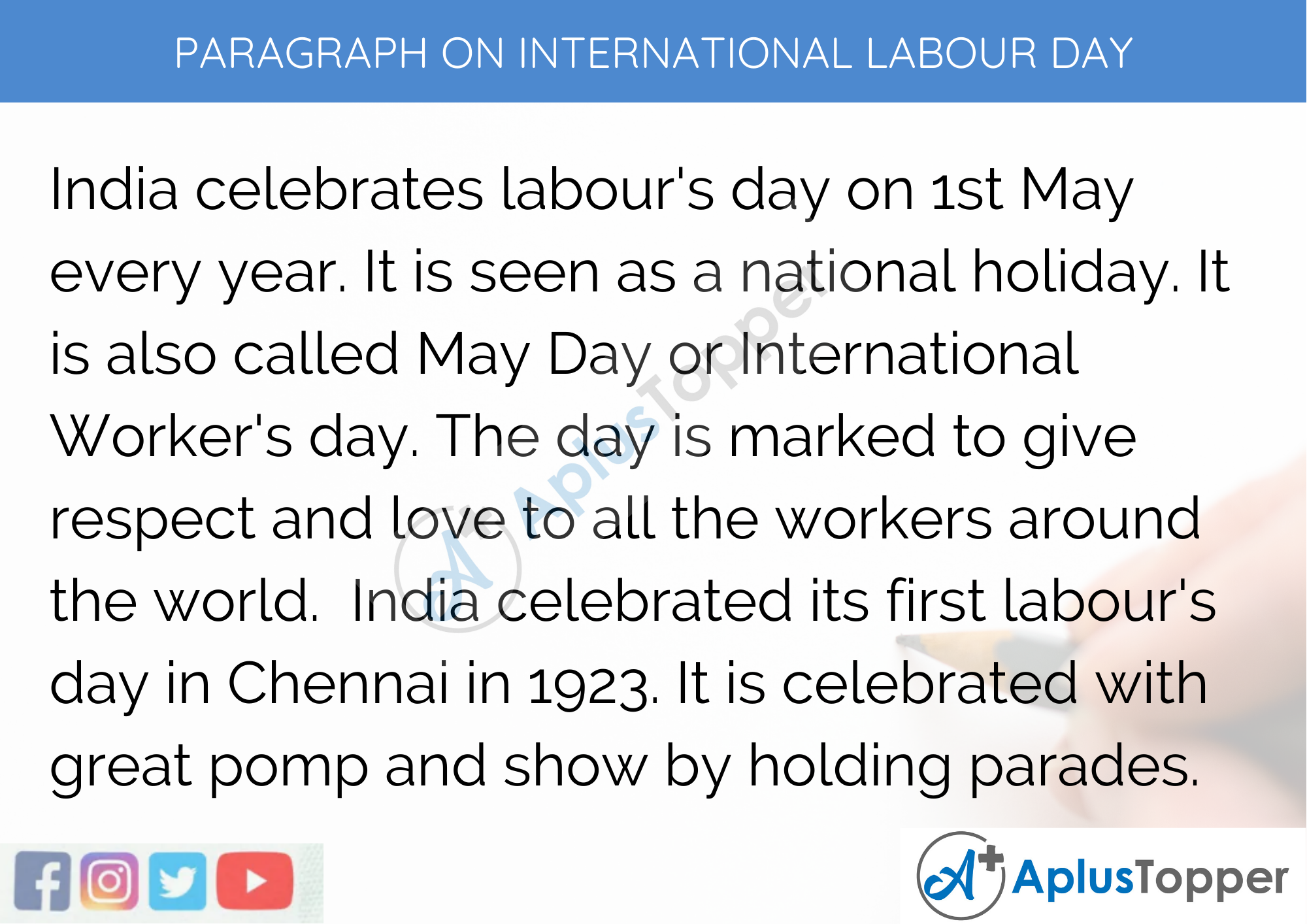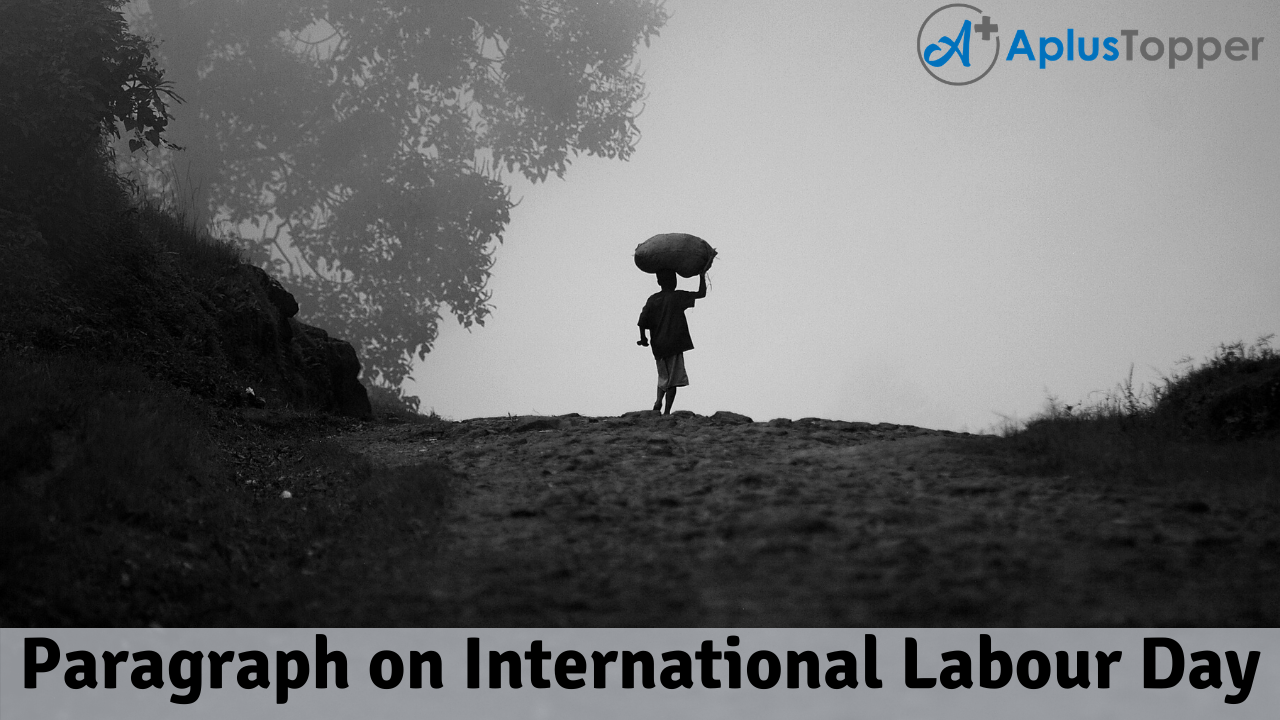Paragraph on International Labour Day: Each year, 1st May is observed as International Labour Day. It is also known as International Workers’ Day or May Day in other parts of the world. The Labour Union Movement, which began in the United States, as a result of the poor treatment of the workers during the Industrial Revolution. Soon the movement spread to various parts of the world. Today, the movement is celebrated as International Labour Day.
You can read more Paragraph Writing about articles, events, people, sports, technology many more.
Paragraph on International Labour Day – 100 Words for Classes 1, 2, 3, Kids
India celebrates labour’s day on 1st May every year. It is seen as a national holiday. It is also called May Day or International Worker’s day. The day is marked to give respect and love to all the workers around the world. India celebrated its first labour’s day in Chennai in 1923. It is celebrated with great pomp and show by holding parades. The workers complained about working more than fifteen long hours a day, and getting very less wages. On 1st May, their demands were met. On this day, we thank all the workers for their hard work for shaping the country.

Paragraph on International Labour Day – 150 Words for Classes 4, 5, Children
India observes Labour’s Day on 1st May every year. The day is also declared as a national holiday in the country. Another name for Labour’s day is May Day or International Worker’s day. The first Labour’s Day in India was celebrated in 1923. The Labour Kisan Party began Labour day from Chennai, India, to bring about a change in the situation of the labourer of India. The labourers used to work for more than fifteen hours a day. However, they were not paid according to the hard work they put in. The labour union expressed their problems. On 1st May, they were successful in seeking solutions from the government. The Labour’s day helped in establishing eight-working hours for labourers with adequate wages. From that day, 1st May is celebrated as remembered as Labour’s Day in most part of the world. On this day, we are thankful to all the workers who help in building the country.
Paragraph on International Labour Day for 200 words for Class 6, 7, 8, Students
May Day is another name of International Labour’s Day, celebrated on 1st May every year. It is also called the International Worker’s Day. 1st May is dedicated to the workers around the globe. The foundation of Labour day was laid in 1923 in India. The Labour Kisan Party initiated Labour’s day from Chennai, India, to bring about a reform in the labour class of India. During the Industrial Revolution, the labourers were not treated with respect. They were made to work in harsh conditions for more than fifteen hours each day. Despite their hard work, they were not paid adequately. So, during the peak of maltreatment of the Industrial Revolution, the labour union protested. They demanded fair working hours and appropriate wages for their hard work. On 1st May, their demands were fulfilled. As a result of their success, 1st May of every year is celebrated as International Labour’s Day in various continents.
Students can get a Essay on Labour Day and Speech on Labour Day from here.
Paragraph on International Labour Day – 250 to 300 Words for Classes 9, 10, 11, 12 and Competitive Exams Students
The International Labour Day, which is observed on 1st May annually in India, is a tribute to all the workers for their contributions toward building the nation’s economy. The Labour Kisan Party initiated International Labour’s day in Chennai, India. India celebrated its first labour’s day in May 1923. Approximately eighty countries, including India, celebrate the international labour’s day on 1st May, whereas the western continents observe labour’s day in September’s first Monday.
The labour class across the continents were maltreated and were compelled to work twelve to fifteen hours per day for seven days in a week. Even children were forced to work in factories, mills, and mines. They were not paid appropriately for their efforts. They lived below the poverty line and could not afford basic necessities. In the late 1800s, they demanded recognition for their hard work and reduced working hours. The history of celebrating labour’s day originated from the United States of America, during the peak of the Industrial Revolution, where the workers sang in unison for equality. The labourers were subjected to hardship and cruelty. As a result of the protest of the labour union movement, they were compensated with proper wages. After the victory of the labour union movement, their working hours were reduced from fifteen working hours to eight working hours with paid leave.
Labour’s day is marked as a remembrance of their victory. It is celebrated with pomp and show with street parades, parties, and unique athletic events. The workers are the backbone of every nation. A country cannot see economic progress and industrial growth without the contribution of workers. Thus, on International labour’s day, we can pay our gratitude to all the workers.

FAQ’s on Paragraph on International Labour Day
Question 1.
In which year did India celebrate its first May Day?
Answer:
India celebrated its first May Day or international labour’s day in May 1923 in Chennai. In India, another name of labour’s day is Kamgar Din.
Question 2.
What is the purpose of celebrating international labour’s day?
Answer:
International labour’s day is observed to celebrate the efforts of the working classes in building the nation’s economy. The annual celebration of labour’s day symbolizes the victory of the labour union movement for promoting the welfare of the labourers.
Question 3.
How do people celebrate international labour’s day?
Answer:
People host barbecues, picnics, parties, etc. for friends and family members to celebrate international labour’s day. People also organize athletic events, take part in street parades, etc. with fun and frolic.
Question 4.
What is the significance of the international worker’s day?
Answer:
The international worker’s day or international labour’s day marks the end of exploitation, prolonged working hours, maltreatment towards the labourers and working classes across the continents. In the late 1800s, the labour union initiated a movement to raise their voice against the unfair and unjust treatment toward labourers.
